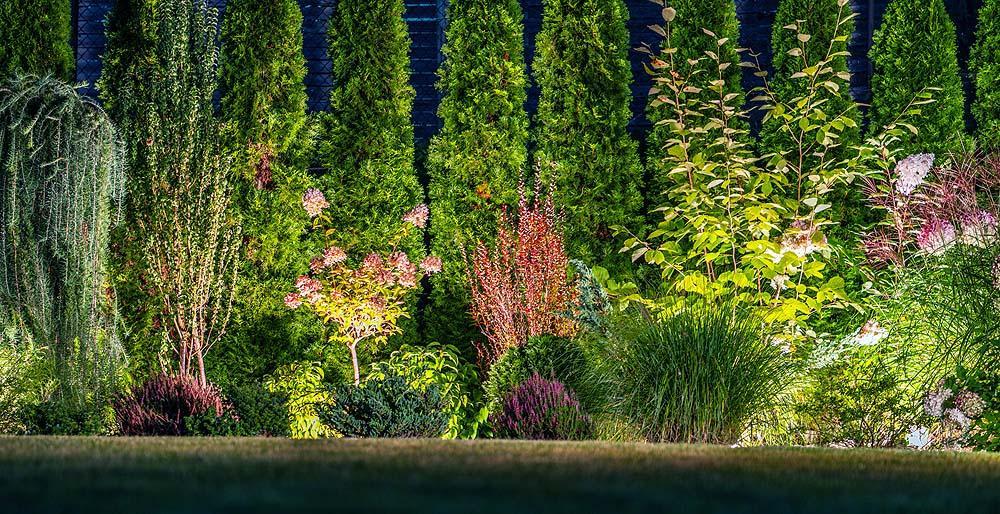
Landscape Lighting Tips And Tricks: Master Your Garden's Nightscape
Share
By Steven Stead
This guide will help you transform your garden into a captivating night-time retreat by offering practical landscape lighting design tips to illuminate your outdoor space effectively, enhancing both beauty and safety.
You can get a better idea of the types of lights used in our Light For The Garden page.
Key Techniques for Stunning Landscape Lighting:
Uplighting: Dramatic Elevation
- Tip: Position lights at the base of trees or architectural features, aiming upwards to highlight texture and form.
- Design Trick: Use narrow beam angles for a focused, dramatic effect. Shield lights to minimise glare and prevent light pollution.
- Caution: Avoid excessively bright uplighting on delicate foliage.

Downlighting: Natural Moonlight Simulation
- Tip: Mount fixtures high in trees or structures for a soft, ambient glow, mimicking moonlight.
- Design trick: Layer downlighting with other techniques to create depth.
- Installation Note: Professional installation is recommended for high-mounted fixtures.
Spotlighting: Focused Focal Points
- Tip: Employ focused beams to accentuate sculptures, water features, or architectural details.
- Design Trick: Utilise varying beam widths to create dynamic highlights and shadows.
- Placement: Carefully position spotlights to avoid harsh glare.

Silhouetting: Artistic Outlines
- Tip: Place lights behind objects to create striking silhouettes against a backdrop.
- Design Trick: Use plants with distinct outlines for maximum impact.
- Requirement: Requires a suitable backdrop like a wall or fence.

Shadowing: Depth and Dimension
- Tip: Strategically position lights to cast intriguing shadows, enhancing depth.
- Design Trick: Experiment with light angles to create unique shadow patterns.
- Style Consideration: Ensure shadowing complements your garden's overall style.
Grazing: Texture Accentuation
- Tip: Place lights close to surfaces to highlight textures like brick or stone.
- Design Trick: Use low-wattage fixtures for a subtle, elegant effect.
- Caution: Avoid overly bright grazing, which can appear harsh.

Moonlighting: Calm Ambiance
- Tip: Install downlights high in trees for a gentle, moonlit atmosphere.
- Design Trick: Combine with path lighting for a cohesive, relaxing ambience.
- Benefit: Minimises light pollution compared to uplighting
Cross Lighting: Three-Dimensional Effects
- Tip: Illuminate objects from two angles to enhance depth and reduce harsh shadows.
- Design Trick: Use slightly different light intensities for a natural look.
- Planning: Requires careful fixture placement and planning.
Path Lighting: Safety and Guidance
- Tip: Use low-level lights to illuminate walkways and pathways for safe navigation.
- Design Trick: Space lights evenly for consistent illumination and visual appeal.
- Safety: Prioritise path lighting for safety in dark areas.

Landscape Lighting Design Tips: Frequently Asked Questions
Q: What lights suit different techniques?
A: Spotlights offer versatility. Floodlights are ideal for broad illumination. Well lights create subtle accents. Path lights illuminate walkways.
Q: How do I minimise glare?
A: Use fixtures with glare shields, position lights away from direct eye level, and opt for warm-toned bulbs.
Q: Best practices for lighting water features?
A: Combine underwater lights with spotlights for a dynamic effect. Consider colour-changing lights for added visual interest.
Q: DIY or professional installation?
A: Simple solar or battery-powered setups are DIY-friendly. Mains-powered or complex systems require a qualified electrician.
Q: How do I maintain landscape lighting?
A: Regularly clean fixtures and lenses. Inspect wiring and connections. Replace bulbs and batteries promptly.
By applying these landscape lighting tips and design tricks, you'll create a stunning and functional outdoor space that can be enjoyed year-round. Learn more in a related blog post How To Light Up Your Garden At Night.
